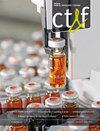催化裂化中的石化助剂
IF 0.5
4区 工程技术
Q4 ENERGY & FUELS
引用次数: 2
摘要
本研究是基于现有的方案,然后是一个具有催化裂化能力的炼油厂,以处理新的原料,如直馏石脑油和来自FCC的石脑油。这些原料对石油化工生产乙烷、乙烯、丙烯、i-丁烷、甲苯和二甲苯具有重要意义。为了评估这些新流相对于带裂解电荷的残留物的潜力,对中试工厂获得的反应器产品中的碳[C1-C12]中的结构基团进行了详细的化学分析。采用了含丙烯助剂和不含丙烯助剂的催化剂。本研究分析了原料化学成分的差异,并将其与每种石化产品的收率联系起来。直馏石脑油中n[C5-C12]和i[C7-C12]烷烃和烷烃含量高的石脑油对生产i-丁烷和丙烷具有选择性,而n[C5-C12]烯烃、i-烯烃和芳烃含量高的催化裂化石脑油对丙烯、甲苯和二甲苯的选择性更强。对于石脑油的催化裂化,添加剂对所有石化产品的选择性相似,添加量为4%时,其收率提高约1点,而在渣油的催化裂化中,添加剂可使丙烯收率提高3点,选择性为50% (ΔC3= / ΔLPG)。本文章由计算机程序翻译,如有差异,请以英文原文为准。
PETROCHEMICAL PROMOTERS IN CATALYTIC CRACKING
This study is based on the current scheme followed by a refinery with available Catalytic Cracking capacity to process new feedstocks such as Straight Run Naphtha and Naphthas from FCC. These feedstocks are of petrochemical interest to produce Ethane, Ethylene, Propylene, i-Butane, Toluene and Xylene. To evaluate the potential of these new streams versus the Cracking-charged Residues, it was performed a detailed chemical analysis on the structural groups in carbons [C1-C12] at the reactor product obtained in pilot plant. A catalyst with and without Propylene - Promoter Additive was used. This study analyzes the differences in the chemical composition of the feedstocks, relating them to the yield of each petrochemical product. Straight Run Naphthas with a high content of Naphthenes, and Paraffines n[C5-C12] and i[C7-C12] are selective to the production of i-Butane and Propane, while Naphthas from FCC with a high content of n[C5-C12]Olefins, i-Olefins, and Aromatics are more selective to Propylene, Toluene, and Xylene. Concerning Catalytic Cracking of Naphthas, the Additive has similar selectivity for all the petrochemical products, their yields increase by about one point with 4%wt of Additive, while in cracking of Residues, the Additive increases in three points Propylene yield, corresponding to a selectivity of 50% (ΔC3= / ΔLPG).
求助全文
通过发布文献求助,成功后即可免费获取论文全文。
去求助
来源期刊

Ct&f-Ciencia Tecnologia Y Futuro
Energy-General Energy
CiteScore
1.50
自引率
0.00%
发文量
7
审稿时长
>12 weeks
期刊介绍:
The objective of CT&F is to publish the achievements of scientific research and technological developments of Ecopetrol S.A. and the research of other institutions in the field of oil, gas and alternative energy sources.
CT&F welcomes original, novel and high-impact contributions from all the fields in the oil and gas industry like: Acquisition and Exploration technologies, Basins characterization and modeling, Petroleum geology, Reservoir modeling, Enhanced Oil Recovery Technologies, Unconventional resources, Petroleum refining, Petrochemistry, Upgrading technologies, Technologies for fuels quality, Process modeling, and optimization, Supply chain optimization, Biofuels, Renewable energies.
 求助内容:
求助内容: 应助结果提醒方式:
应助结果提醒方式:


